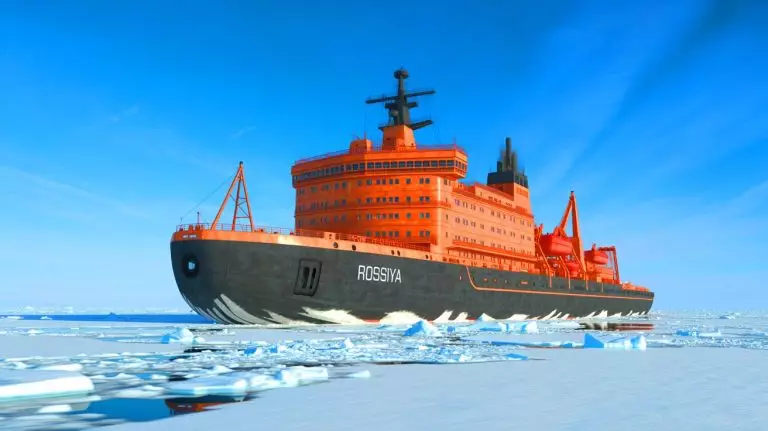| IN A NUTSHELL |
|
Russia has taken a monumental step in the realm of Arctic navigation with the unveiling of the first ‘RITM-400’ nuclear reactor, designed to power the under-construction ‘Rossiya’ nuclear icebreaker. As the world climate continues to change and the Arctic ice caps melt, the need for advanced icebreaking technology becomes increasingly pressing. The new reactor, a product of Rosatom’s Machine-Building Division, promises to make ‘Rossiya’ the most powerful vessel of its kind, capable of navigating the treacherous Arctic seas. This development represents a giant leap forward for Russia’s nuclear icebreaker fleet and underscores the nation’s strategic ambitions in the Arctic region.
Revolutionizing Icebreaking Capabilities
The completion of the RITM-400 reactor marks a significant achievement for Russia’s nuclear industry. As an evolved version of the RITM-200, the new reactor delivers a powerful 315 MWt and 120 MW of propeller power. This allows the ‘Rossiya’ to penetrate ice up to 14 feet thick and clear channels up to 164 feet wide. Such capabilities are unprecedented and highlight Russia’s commitment to dominating Arctic navigation. The chief of Rosatom, Alexey Likhachev, emphasized the reactor’s importance, noting it as a historic milestone for the icebreaker fleet and the entire country.
The reactors are not only technical marvels but also cultural symbols, as each unit is named after legendary Russian heroes, Ilya Muromets and Dobrynya Nikitich. These names were chosen to reflect the reactors’ extraordinary power and their role in overcoming Arctic challenges. The significance of these reactors extends beyond their immediate function, representing a blend of technological prowess and national pride.
Making ‘Rossiya’ the Most Powerful Icebreaker
As the world’s most powerful nuclear icebreaker, the ‘Rossiya’ is set to redefine what is possible in Arctic exploration. Igor Kotov, Head of Rosatom’s Machine Building Division, stated that the second RITM-400 unit will soon be completed and installed on the vessel. This development is set to coincide with the 80th anniversary of the nuclear industry, symbolizing decades of progress and innovation.
The ‘Rossiya’ is the first vessel in Project 10510, a series aimed at creating state-of-the-art nuclear icebreakers. With a target service date of 2030, the ship will enhance Russia’s presence in the Arctic. Its capabilities promise new opportunities for developing the Northern Sea Route, which is pivotal for international shipping and trade. By offering an alternative to the Suez Canal, the route significantly reduces transit time from Murmansk to Japanese ports, transforming global maritime logistics.
Strategic Importance of Nuclear Icebreakers
The strategic value of nuclear icebreakers cannot be overstated. These vessels are essential for maintaining Russia’s influence over the Northern Sea Route, a passage that cuts shipping distances and time considerably. Nuclear icebreakers offer unparalleled advantages, including the ability to operate for extended periods without refueling, crucial for Arctic missions where diesel is insufficient and costly.
Russia is currently constructing multiple nuclear icebreakers, including ‘Chukotka’, ‘Leningrad’, and ‘Rossiya’, with plans for future vessels like ‘Stalingrad’. These efforts underline Russia’s commitment to securing its Arctic borders and facilitating year-round sea passages. The Northern Sea Route spans 3,479 miles and connects major Russian ports, potentially revolutionizing global trade routes and reducing reliance on traditional pathways like the Suez Canal.
The Future of Arctic Exploration
As we look to the future, the development of nuclear icebreakers signals a new era in Arctic exploration. These vessels will not only enhance Russia’s strategic capabilities but also contribute to scientific research and environmental monitoring in the Arctic. The ability to navigate previously inaccessible areas opens new possibilities for resource exploration and environmental studies, crucial for understanding climate change impacts.
The strategic and environmental implications of these advancements are vast. As Russia continues to expand its icebreaker fleet, questions arise about the global balance of power in the Arctic. How will these developments influence international relations, and what role will other nations play in the unfolding Arctic narrative?
Did you like it? 4.6/5 (30)








Wow, a floating nuclear beast? Sounds like something out of a sci-fi movie! 🚢💥
Is this really safe for the Arctic environment? 🤔
Thank you for the detailed article, very informative!
Why does Russia need such a powerful icebreaker? What’s the end goal?
Does anyone else find the name “Rossiya” a bit too on-the-nose?
How do these nuclear icebreakers compare to traditional ones in terms of cost efficiency?